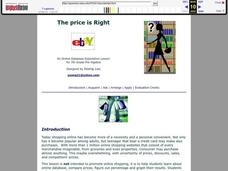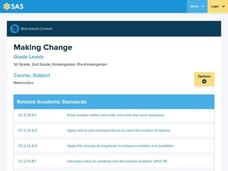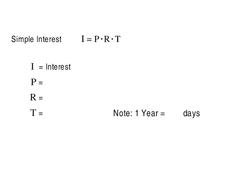Curated OER
Purchasing Flower Power
Students fabricate decorative flowers to serve as a sales commodity. They assign value and prices to their flower stems. Students estimate and calculate costs using decimal points and place values in order to keep within a budget they...
Curated OER
Choosing Coins
In this mathematics worksheet, 1st graders identify what coins can be used to buy a toy train. Then they count out how much money is given and write that amount in cents. Students also trace or draw the coins to match each price listed.
Curated OER
Comparison Shopping & Buying Supplies
First graders compare prices to determine the best buy. They earn money, by correctly completing math problems. Earnings are used to purchase items from a store using exact change.
Curated OER
The Price is Right
Learners, through various activities, explore online databases. Using the internet, students explore the distributors websites. They collect specific information on selected products. An spreadsheet with price comparisons is developed....
Curated OER
What Does It Cost to Use It?
Students investigate how electrical usage is counted. For this electricity lesson, students research an electric bill and define terms such as watts and kilowatts. Students calculate the average electricity cost per year by using a...
Curated OER
Price
First graders complete worksheets on producers and consumers and the total price of a group of items. In this price lesson plan, 1st graders read the book A Dollar for Penny in order to understand price, producers, and consumers, and...
Curated OER
What's the Price?
Fourth graders learn about price and comparative shopping. In this price and comparative shopping lesson, 4th graders read Amy Axelrod's, Pigs Go To Market: Fun with Math and Shopping. They use the book to investigate the meaning of...
Council for Economic Education
One is Silver and the Other's Gold
Learners investigate the money supply and how it can affect the value of money. They examine how the changing money supply can affect prices.
Curated OER
How E-Commerce Influences Consumer Choice
Class members gather information on different brands of athletic shoes to determine which is the best buy. They identify a toy they would like to buy, and gather comparative information from a store, a catalog, and three websites.
Curated OER
The Discount Is Right
Students estimate and calculate the sale price of five items using the original price and a designated rate of discount. They use percent to calculate the rate of discount and the original.
Pennsylvania Department of Education
Making Change
Pupils make change from play money they use based on prices mentioned in a book they read. In this making change lesson plan, students use subtraction to find their change amount.
Curated OER
Party Time
Students explore the cost of a party. In this math lesson, students plan a party and determine the cost of hosting a party. Students use information from grocery stores to determine the unit cost of items for the party.
Curated OER
Simple Interest
In this simple interest worksheet, students calculate the interest, price, rate, and time for word problems. Students complete 3 problems total.
Curated OER
Bon Voyage Math
Sixth graders investigate the cost of throwing a party. In this cost of throwing a party lesson, 6th graders have to throw a going away party for 2 exchange students given a $350 budget. Students work in groups to determine the best...
Curated OER
Coins - Price
In this consumer math worksheet, learners look at a price tag that is shown in each of 5 boxes. They circle the coins, which include dimes, pennies, and quarters, that match the price.
Curated OER
Gross Domestic Product in the Real World
High schoolers gain knowledge of Gross Domestic Products and how they are used as an economic indicator. They bring articles that mention GDP and decide how it is used in articles. Students present orally their findings to the class.

















